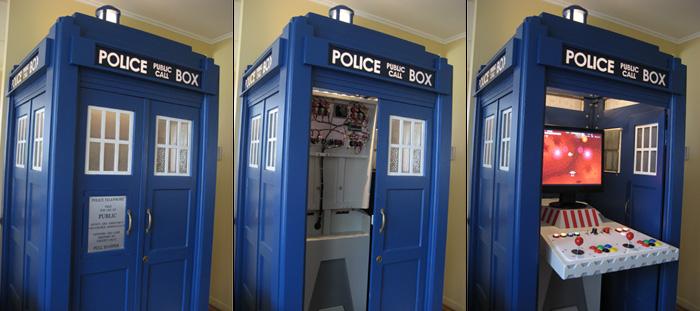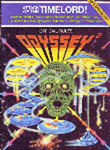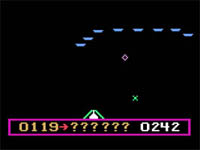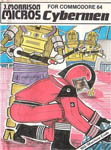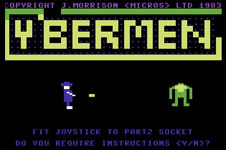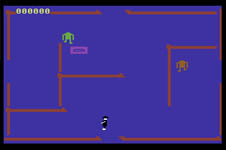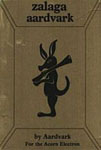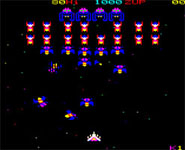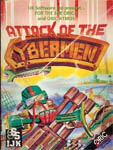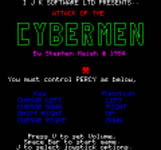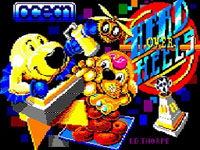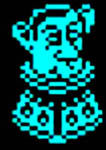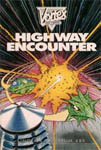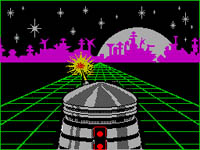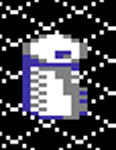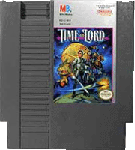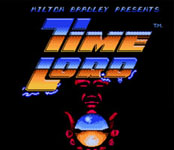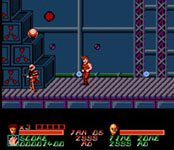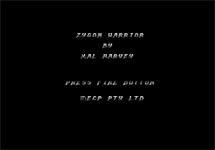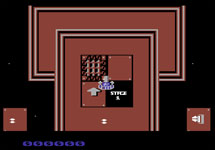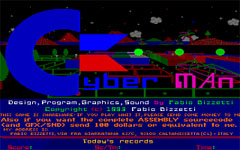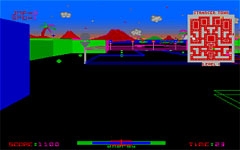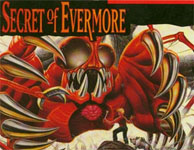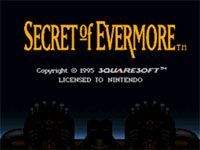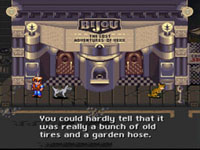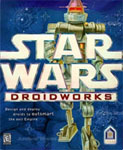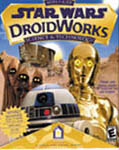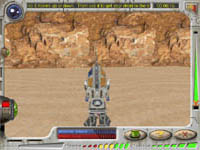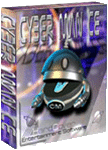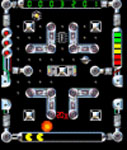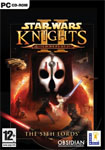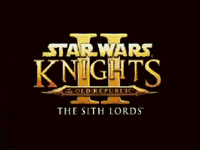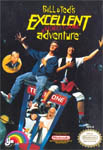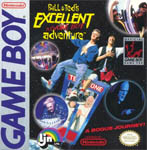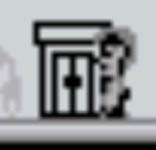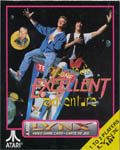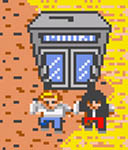1983 – Attack of the Timelord!
A pioneering game for the Odyssey2 this may be. One of the best uses of the 70s system’s sound capabilities it may have. Fast and frantic and generally very cool are other ways it can be described. It is not, however, a Doctor Who game. The Timelord in question is a green blob hell bent on taking over the galaxy.
It’s not even a rogue Time Lord, since the instructions refer to the titular villain as Spyrus the Deathless – Timelord of Chaos and it’s unlikely a programmer would use his favourite TV show for inspiration, then invent a character and mis-spell his title (it’s “Time Lord”, not “Timelord” you moron!). In any case, it was renamed Terrahawks for the the European release, to tie in with the Gerry Anderson series.
1983 – Cybermen
The followup to J Morrison’s Bonka (probably best that you don’t ask) sees the title character of ‘man in a black hat’ trying to retrieve bars of Platignum from a maze patrolled by Cybermen, and was coded exclusively for the Commodore C64. From the in-game instructions..: “The object of the game is to collect as much Platignum as possible. This is scattered at random throughout the maze, which is patrolled by Cybermen. You begin with 3 lives and the scoring is as follows: Cyberman 100 Pts, Platignum Bar 500 Pts. A bonus of 100 Pts is earned if you manage to shoot a Cyberman’s bullet before it hits you. The overseer appears periodically and is indestructible, the only escape is through any of the open doors. Your man can only fire when moving, in the direction of travel. Good luck. Any key to start.” It seems likely that the name is just a coincidence, as the Cybermen certainly don’t look like their TV counterparts!
1983 – Zalaga
No obvious Doctor Who references here… except that three years after being released for the BBC Micro, this game would turn up in The Trial of a Time Lord episodes 9-12, as a futuristic Space Invaders clone.
Doctor Who was guilty of this quite a bit in the 80s – a blind belief that the BBC Micro was the height of computer technology – this despite it being quickly beaten in technological terms by the ZX Spectrum 48K, and then by the Commodore C64 and the Amstrad CPC464. And someone’s microwave.
Favourites include the TARDIS’ display of the Dark Tower in The Five Doctors (its on-switch also made a nice beeping noise in UNIT HQ in the same story), the Sentinel Satellite rays in Warriors of the Deep, the TARDIS’ display AGAIN (this time showing the time corridor) in Resurrection of the Daleks… Did they not think any fans owned a BBC?
1984 – Attack of the Cybermen
Hm. 1984. The year Attack of the Cybermen is broadcast. And the year Attack of the Cybermen is released on the Oric and Oric-1.
Do we smell a tie-in?
Well, no, we don’t. In fact it’s a game about a little guy called Percy who fights off armies of little bugs, called Cybermen. The gameplay is identical to Robotron (down to walking in one direction while firing in another).
A lazy conversion with an even lazier name.
1984 – Travels with the Trashman
At the end of the classic Spectrum game Travels with the Trashman, the eponymous hero discovers a time machine in New Orleans. Rumour has it the planned sequel, which would never see the light of day, would have been based on Doctor Who.
1985 – Timelord
Another mis-spelled Time Lord here – this one was the Amstrad-exclusive adventure game from Omega Software. As garish and complex as Colin Baker’s jacket, we’re not truthfully even sure what it’s all about. But its certainly not about Doctor Who!
1986 – Head Over Heels
Often hailed as one of the defining games in 8-bit computing history, Ocean’s Head Over Heels (programmed by the legendary Jon Ritman and Bernie Drummond) featured what some have described as a ‘Prince Charles Dalek’.
At TME, we’re yet to be convinced (although we did host a page dedicated to HOH for some years – everyone has the right to change their minds!) – judging by the poster artwork and the loading screen, it’s just a chess piece with Charles’ head on, and Ritman’s trademark “squat” sprite design had made it look a little Dalek-ish.
The game was released across all major 8-bit and 16-bit formats at the time (Spectrum, Commodore, Amstrad, Amiga and Atari ST).
1986 – Highway Encounter / Alien Highway: Encounter 2
A an 8-bit game released for the Spectrum, Commodore and Amstrad with a squat robot. The manual describes them as “the Dalek-like Vortons.”
Again, TME were dragged into this mistaken belief for many years, but these guys really aren’t Daleks. The top of their heads look a LITTLE Dalek-like on the cover artwork. But in-game? No chance!
1989 – Time Lord
Well, unlike the earlier Odyssey2 game, this NES classic does spell the word correctly. But unless the thirteenth Doctor is a muscly red-clad hero from the year 2999 who goes around beating people up to rescue some orbs that are scattered around time, we’re guessing this is a no-no too.
1990? – Zygon Warrior
Well, we honestly don’t know what was going through the mind of Mal Harvey (aka ECP PTY Ltd) when he designed this very lazy game wtih the C64’s Shoot Em Up Construction Kit, using unfinished sprites and the system’s default sounds. Perhaps we was thinking about some big thrilling adventure surrounding the characters from Terror of the Zygons…
But personally, we hope not.
1993 – Cyber Man
A 3D version of popular arcade coin-op PacMan, coded by Fabio Bizzetti for the expanding “PD” (public domain, later known more commonly as homebrew) circuit growing for the Commodore Amiga.
Bizzetti would later go on to code the critically acclaimed Virtual Karting.
Definitely nothing vaguely Doctor Who related here. Move along…
1995 – Secret of Evermore
This game features a dog that turns into a robot at one point. The robot in question looks nothing like K9, but that doesn’t stop eager fans from misunderstanding. It’s a fun cartoon adventure, though, so if you’ve got a SNES it’s worth looking for.
1998 – Doctor Who Theme

Released in 1982, the GCE Vectrex appeared on the market at a time when the Atari VCS still ruled supreme, and other consoles had already risen and fallen.
Although it was disbanded two years later, with barely 50 games to its name, it developed a cult following (partially due to the novelty of a built-in screen) and many home users would continue creating cartridges for it for years.
In 1998, one Chris Salomon begin coding a series of carts featuring his favourite music against a black screen. Why is anyone’s guess, but he did release a rather kicking version of the Doctor Who theme.
1998 – Star Wars: Droidworks
Released by LucasArts in the late 90s, this formed part of a series of games that Star Wars creator George Lucas hoped would encourage children to academic excellence through the fantasy worlds he had created. It was discontinued a few years later, and now goes for silly money on eBay (often over $75 – and you thought Doctor Who fans were crazy). The programmers included a cheat code based on our favourite show – during gameplay pressing enter, then typing TARDIS and entering again gives a teleport option (hitting backspace and then the numbers 1-9). We have no idea if this is accompanied by a natty sound effect (without $75 to spare we could only afford the free demo version, which this doesn’t work on!), but it’s highly unlikely.
2004 – Cyber Man
Help Cyber Man retrieve some computer chips that have been scattered around ten different laboratories, avoiding the computer-controlled security system (made up of three robots that will destroy Cyber Man on contact) and trying to collect power-up chips (four per lab) that will give him power over the other robots. Sounds suspiciously like PacMan.
Absolutely nothing whatsoever to with the previous remake of coin-op PacMan, this game was created by HardCover Entertainment Software for running on handheld PDAs/smartphones using the Windows CE operating system.
It also has absolutely nothing whatsoever to do with Doctor Who. Ho hum.
2004 – Star Wars: Knights of the Old Republic II: The Sith Lords
Those Doctor Who fans hidden at LucasArts are at it again!
In this sequel to the bestselling 2002 game Star Wars: Knights of the Old Republic (set 4,000 years before the events of the films, around the first battles between Jedi and Sith) features a major segment on the planet Telos. No Cybermen to be seen, but you have to wonder if this is someone’s attempts to tie up their two favourite universes… What next, a lightsaber-wielding companion in a Doctor Who game?
In fairness, Telos had already appeared in Kevin J Anderson’s Jedi Academy book series, and also on the starcharts provided with The Star Wars Fact Files partwork and the Attack of the Clones Illustrated Companion (the same star chart that features a planet Rutan in between Hoth and Degobah).
KOTOR2 (as it’s usually known, for the obvious reason that it doesn’t take half an hour to type out – LucasArts just loves their lengthy titles) was released on PC and XBox.
2005 – Second Life
Is it a game? Is it a mod? Who knows…
The 2005 virtual environment Second Life, took off a treat. Not a game, as such, but a pseudo-MMORPG where people meet, chat, barter and so on – designed to be as much like the real world as possible… But, erm, not.
In May 2006, BBC Radio 1 bought an island within the arena, in order to host live music, and by the 13th rumours were flying around that a Dalek had been spotted. Turned out just to be a user with a very cool avatar, but it was certainly a nice thought.
And also…
There’s a coding house calling themselves CyberMan Software and popular hardware producer Logitech made a very nice joystick called the Cyberman.
Also, TARDIS has been used as the name of a variety of time-synching applications from different programmers that help computers keep the right time, and Dalek is the name of a command-line utility for enabling PCs to send syslog messages.
The movie Bill and Ted’s Excellent Adventure (which so marvellously spoofed Doctor Who by squeezing a dozen people into a tiny time-travelling phone booth) also span off games in 1990 for the PC (by Capstone) and in 1991 for the NES/Famicom (by Acclaim), the Gameboy (Acclaim again) and the Lynx (from Atari).
Mad New Zealander Simon Jansen joined the fad of building custom MAME consoles (MAME being a multiple arcade machine emulator, currently supporting several thousand coin-op classics) in 2007 with this rather natty TARDIS thing. Details here.
